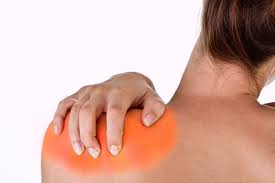Shoulder Pain
 Shoulder pain is by far the most common upper extremity complaint that I encounter in my practice. Sometimes trauma, such as falling on an outstretched hand or lifting heavy weights, can cause shoulder pain. Most of the time, however, patients say that their shoulder pain crept up on them over time. What began as a “pinch” has now evolved into pain at night and an inability to reach behind or overhead. Patients are remarkably resilient in managing pain on their own, but once the pain has affected their ability to participate in an activity they value (golf, tennis, CrossFit, lifting their children) they tend to seek professional treatment.
Shoulder pain is by far the most common upper extremity complaint that I encounter in my practice. Sometimes trauma, such as falling on an outstretched hand or lifting heavy weights, can cause shoulder pain. Most of the time, however, patients say that their shoulder pain crept up on them over time. What began as a “pinch” has now evolved into pain at night and an inability to reach behind or overhead. Patients are remarkably resilient in managing pain on their own, but once the pain has affected their ability to participate in an activity they value (golf, tennis, CrossFit, lifting their children) they tend to seek professional treatment.
Shoulder Injuries
I love to treat the shoulder–its complexity and a rapidly-expanding knowledge base keep me on my toes and capture my interest. Over the years, I have developed comprehensive shoulder examination procedures and implemented rehabilitation programs that have helped many people regain function of their shoulder.
The shoulder is the most complex joint in the body; it has to be loose enough to allow for its incredible range of motion but also tight enough to keep the structure stable. Without a balance of these two dynamics, the shoulder is easily injured. Athletes involved in throwing or overhead sports such as baseball, volleyball, swimming and tennis are particularly prone to internal impingements or impingements secondary to instability. The general population, especially as we age, is prone to primary impingements due to arthritis as well as secondary impingements due to instabilty. Falling on an outstretched hand can also result in shoulder dislocations and rotator cuff tears.
Symptoms of Impingement Due to Shoulder Arthritis (Often Found in People Over 50 years Old):
Pain with overhead activity
Pain with sleeping on the affected shoulder
Pain in the front of the shoulder
If the condition is chronic, pain is not relieved by rest.
Symptoms of Shoulder Instability (Often Found in People Under 50 Years Old):
Recurrent dislocations
Pain with overhead activity
Numbness or tingling in the hand
Pain that is relieved by rest
Treatment of Shoulder Pain
The most important aspect of treatment is to begin with a correct and specific diagnosis. Diagnostic imaging, a thorough history, and a wide array of orthopedic tests help the provider form the diagnosis. Once you have a specific diagnosis, you can begin a customized treatment plan, and then have an optimal outcome in mind.
Too often, patients present at my office having been prescribed generic shoulder exercises that are not specific to their condition; indeed, a 10-year old with Little League Shoulder will have a very different treatment plan than a 65-year old with pain from a degenerated AC joint.
In the case of shoulder instability, treatment should involve: scapular stabilization exercises, rotator cuff strengthening, correcting any forward head posture, posterior capsule stretching, and soft tissue work.
Treatment for primary impingement should involve exercises aimed at getting the shoulders back and down and correcting any forward head posture. Doing this will increase the subacromial joint space thereby allowing more space for the supraspinatus muscle (a rotator cuff muscle) to pass. Surgery may also be required to shave off the bone spurs that are impinging upon the supraspinatus muscle.
Chiropractors Can Treat Shoulder Pain
Many people are unaware of the comprehensive shoulder rehabilitation and maintenance programs offered by chiropractors who have a thorough understanding of the shoulder joint. A chiropractor well versed in shoulder injuries can offer cost-effective treatment that incorporates both active physical therapy and chiropractic manipulations—a useful combination in treatment of shoulder joint dysfunction.
If your shoulder pain has begun to limit your activity or give you trouble sleeping, it is time to have a professional evaluate your shoulder to put you on the right track to recovery.
